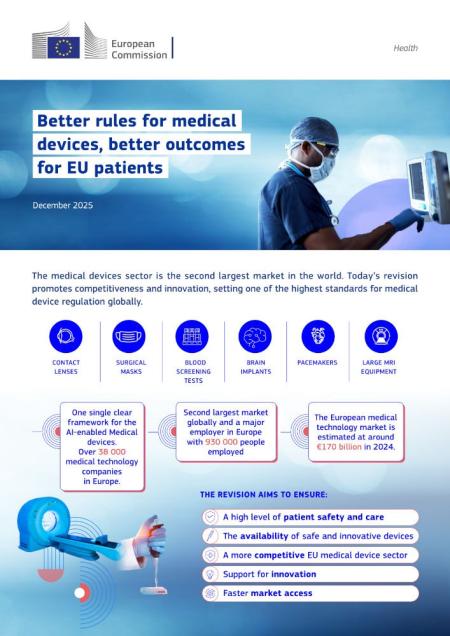The medical devices sector is the second largest market in the world. Today’s revision
promotes competitiveness and innovation, setting one of the highest standards for medical
device regulation globally.
Moderation: H. Schäffler
08.20 Begrüßung und Einführung - F. Reister und S. Andres
08.30 CTG verstehen - Grundlagen der physiologischen CTG-Interpretation, Hypoxieformen und deren Management - A. Schmid
10.00 Plazenta-Transfer Was geht wirklich rüber? pH, BE und Laktat – aber auch Sauerstoff- und Flüssigkeitsgabe - F. Reister
10.45 STAN - Technik trifft Taktik – fetales EKG - G. Schwennicke
11.15 Jenseits der Kurven – die Sicht eines Vaters - Wenn ein Kind Schaden nimmt - J. Steinmacher und B. Steinmacher
11.35 Big Data trifft Kreißsaal - Aus vielen Mustern lernen: Big-CTG-Data-Projekt - M. Daumer
12.05 Computerisiertes CTG - Mehrwerte erkennen - S. Andres
13.20 Is this Baby Fit for Labour? - CTG as Fitness Check - T. Ghi
13.50 Nicht-hypoxische CTG-Veränderungen - Triple I und grünes Fruchtwasser - M. Bolten
15.05 Neues aus der Forschung - Der CTG Journal Club - M. Khodawandi und A. Schmid
15.35 Mythen im CTG: Was ist Fakt, was ist Fantasie? - Jitter, Doppelherz, Kindsbewegung, Wehe – Wie wird alles registriert? - A. Kinzkofer
16.05 Kasuistik - Anwendung des physiologischen CTGs anhand eines Falls - S. Andres
16.35 Ausblick und Verabschiedung - F. Reister
Wie verändern KI und digitale Technologien die medizinische Diagnostik und Versorgung? Welche Chancen ergeben sich daraus für Forschung, Entwicklung und Gesundheitswirtschaft in der Region? Diesen Fragen widmet sich die gemeinsame Veranstaltung des VDI und unseres Partners CSI am 3. Juli 2025 in München: Die Veranstaltung bringt führende Akteure aus Industrie, Forschung und Verbänden zusammen, um Innovationen in der Medizintechnik mit Schwerpunkt Künstliche Intelligenz (KI), Neurotechnologie, Simulation & Digital Twin sowie Wearables zu präsentieren und zu diskutieren. Die Teilnehmerzahl ist beschränkt. Sollte die Veranstaltung ausgebucht sein, führen wir eine Warteliste unter: bv@vdi-sued.de Anreise: ÖPNV: U4/U5 Heimeranplatz, Parken in der Tiefgarage möglich.
Agenda Monday, 30.06.25
Foundation & Mechanism
9:30 Prof. Dr. Aldo Faisal (Universität Bayreuth & Imperial College London): Chair’s note -
Unlocking understanding with data-driven human behaviour
10:00 Prof. Dr. Greg Stephens (Vrije University Amsterdam & Okinawa Institute): Quantitative models of Behaviour
11:00 Prof. Dr. Constantin A. Rothkopf (TU Darmstadt): Computational elements of human
ethomics
12:00 Dr. Shlomi Haar (Imperial College London): Real-World Neurobehavioral Tracking of
Parkinson's Disease and Treatment Effects
Quantitative Live-in-Lab (QLiLa) with Dr. Chaiyawan Auepanwiriyakul & Lena Patricia Nieper (Universität Bayreuth)
Clinical Applications (Chair: Sinead O’Connor, Ethomix Ltd)
15:00 Prof. Dr. Martin Daumer: Wearable based outcomes for MS
15:40 Dr. med. Amr Nimer (Imperial College London): The Ethomics of Neurosurgery: how machine learning can help identify signatures of surgical expertise
16:20 Dr. med. Lars Masanneck (Universitätsklinikum Düsseldorf): Digital Health Technologies – Concepts and Clinical Translation.
17:00 Networking Break with Poster Session
18:00 Round Table (live streamed) Human Behaviour: Unlocking the Missing Vital Sign with AI
Agenda Tuesday, 01.07.25
9:00 Motion Capture Training Workshop for Clinical Trials & Assessments with Dr.
med. Amr Nimer and Dr. Chaiyawan Auepanwiriyakul (registration required)
(Venue: Alte Spinnerei 124)
11:00 Research Collaborators Workshop with Spot Lights (by invitation)
9:00 Investigator’s Networking Breakfast & Coffee in Kulmbach
(by invitation)
Abstract
"Cardiotocography (CTG), introduced in the 1960s, was initially expected to prevent hypoxia-related deaths and neurological injuries. However, more than five decades later, evidence supporting the evidence of intrapartum CTG in preventing neonatal and long-term childhood morbidity and mortality remains inconclusive. At the same time, shortcomings in CTG interpretation have been recognised as important contributory factors to rising caesarean section rates and missed opportunities for timely interventions. An important limitation is its high false-positive rate and poor specificity, which undermines reliably identifying foetuses at risk of hypoxia-related injuries. These shortcomings are compounded by the technology's significant intra- and interobserver variability, as well as the subjective and complex nature of fetal heart rate interpretation. However, human factors and other environmental factors are equally significant. [...]"
doi.org/10.1111/1471-0528.18097




